Bolloré bounce boosts CMA CGM Q2 revenues, but job worries persist
CMA CGM Group has announced a “robust performance” in the second quarter, with revenues up ...
TFII: SOLID AS USUALMAERSK: WEAKENINGF: FALLING OFF A CLIFFAAPL: 'BOTTLENECK IN MAINLAND CHINA'AAPL: CHINA TRENDSDHL: GROWTH CAPEXR: ANOTHER SOLID DELIVERYMFT: HERE COMES THE FALLDSV: LOOK AT SCHENKER PERFORMANCEUPS: A WAVE OF DOWNGRADES DSV: BARGAIN BINKNX: EARNINGS OUTODFL: RISING AND FALLING AND THEN RISING
TFII: SOLID AS USUALMAERSK: WEAKENINGF: FALLING OFF A CLIFFAAPL: 'BOTTLENECK IN MAINLAND CHINA'AAPL: CHINA TRENDSDHL: GROWTH CAPEXR: ANOTHER SOLID DELIVERYMFT: HERE COMES THE FALLDSV: LOOK AT SCHENKER PERFORMANCEUPS: A WAVE OF DOWNGRADES DSV: BARGAIN BINKNX: EARNINGS OUTODFL: RISING AND FALLING AND THEN RISING

Oslo-listed feedership owner MPC Container Ships (MPCC) has posted a net loss of $10.7m for the first quarter and warned investors of its exposure to “significantly reduced charter rates”.
CEO Constantin Baack said that, but for its capital expenditure and off-hire deductions related to scrubber retrofits on ten vessels, Q1 should have seen the shipowner move into the black for the first time since its 2017 formation.
And he said MPCC had been affected during the period by the rapid decline in daily hire rates in the sector, which have slumped by 17% since January.
But he added that worse was to come.
“Following the outbreak of Covid-19, the group is experiencing significantly reduced charter rates and utilisation of its fleet due to lower containerised volumes globally,” said Mr Baack.
Total revenue in Q1 from its fleet of 68 feeder vessels was $46m, compared with $44.2m the year before, but utilisation was down to 89% from 96%, reflecting the scrubber retrofitting on 10 ships supported by long-term charters with a major ocean carrier.
However, around a third of MPCC’s fleet operates in the spot market, which brokers have told The Loadstar is “dead”, and now has some 162 feeder ships idled around the world.
And although MPCC has several ships fixed on charter with the likes of Maersk, MSC, Hapag-Lloyd, CMA CGM, OOCL and ONE, many of these agreements expire this year and are unlikely to be extended. Indeed, Hapag-Lloyd CEO Rolf Habben Jansen said this year the carrier “would probably return 15-20 ships” to owners.
And with carriers now firmly battening down their hatches to try and ride out the coronavirus demand crisis, off-hiring surplus tonnage is high on their agenda, with the emphasis on saving costs.
So beside MPCC’s difficulty in fixing its idled tonnage, any deals its brokers do manage will be at considerably lower hire rates, and with terms and conditions, including ballasting ships, dictated by the charterer.
In Q1, MPCC’s average daily hire rate across its fleet stood at a healthy $8,969, up on the $8,505 average of the final quarter of last year. This compares with an average operating cost of $4,624, down on the $4,844 of Q4 19.
However, as the year progresses and ships are returned by charterers, the margin between daily hire rates and operating costs is likely to erode considerably, with some brokers already talking of a return to the sub-economic lows of 2016-2017.
And Mr Baack also noted that the S&P [sales and purchase] market was “extremely dry”, with a few recent sales having been done “at scrap prices”.
He described 2020 as a “year that will go down in the history books” for the severity of the impact on global economies, and said the company would engage with its lenders “to address Covid-19-driven covenant and liquidity challenges”.
Comment on this article